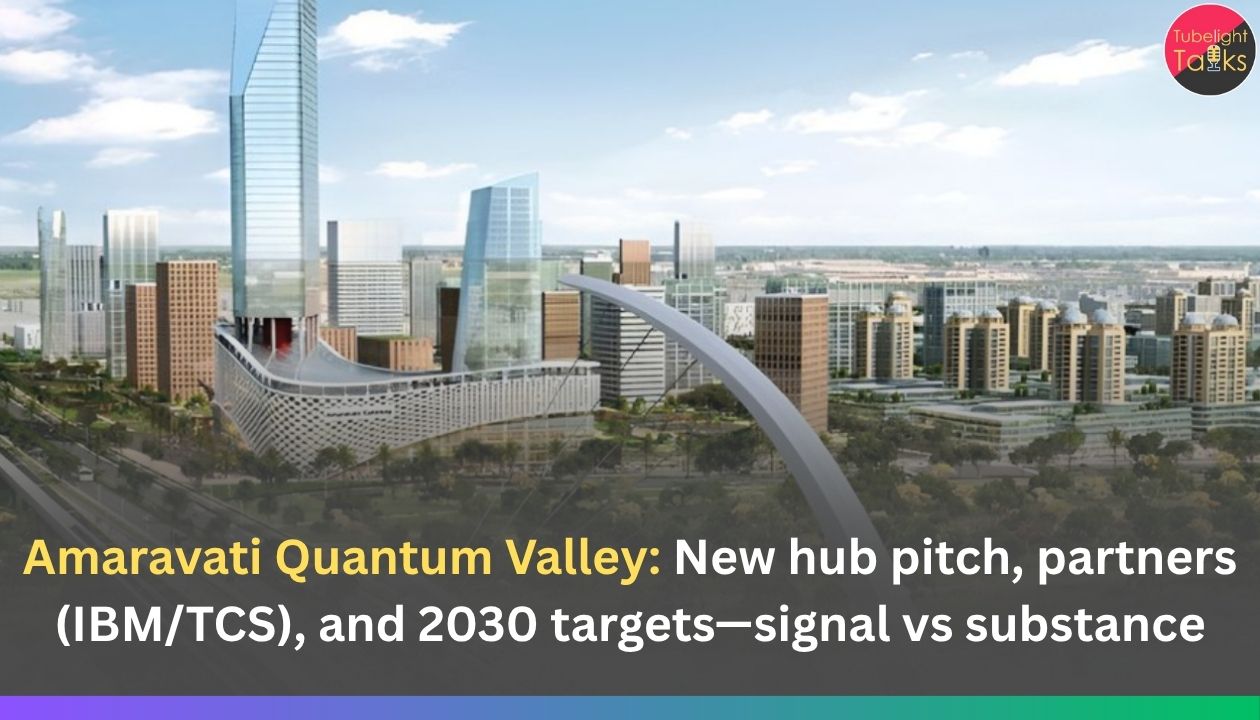Andhra Pradesh is pitching Amaravati Quantum Valley (AQV) as India’s first quantum tech park. The formal centrepiece is an IBM–TCS partnership to deploy an IBM Quantum System Two in Amaravati—envisioned with a 156-qubit Heron processor, which would be the largest quantum computer in India on go-live. IBM’s newsroom and TCS’s release confirm the plan and name the partners.
What’s officially on the table (the “signal”)
- Anchor system & partners: IBM + TCS + Govt of Andhra Pradesh; IBM Quantum System Two (Heron, 156 qubits) planned for the Quantum Valley Tech Park in Amaravati.
- Timeline guidance: IBM execs and local coverage suggest a Q1–Q2 2026 operational window for the first installation, aligning with the park’s initial phase. (IBM newsroom; TOI reportage.)
- Testing/benchmarks lab: India’s first Quantum Reference Facility announced at AQV with ₹40 crore outlay—to validate components and reduce import dependence for characterisation.
- State policy & land: AP notifications and local reports reference AQV orders/declaration and land allocation for the park and associated institutions in Amaravati.
The ambition deck (treat as “targets,” not done deals)
- Multiple systems by 2027; 3,000-qubit aim by 2030; exports jobs & campus scale—these appear in state presentations/media briefings (e.g., five systems by 2027, 3,000 qubits, ₹5,000-crore exports, 80-lakh sq ft, ~90,000 jobs). These are goals, not vendor-filed commitments or purchase orders. Use them as context, not confirmed deliverables.
- “Top-5 global hub by 2030” language shows up in coverage, not in binding partner documentation.
What to watch in 2026 (substance checks)
- Site readiness & utilities: clean power, cooling, vibration control for the System Two room; fit-out permits. (Check monthly state progress notes.)
- System delivery milestones: crate-in, calibration, first circuits, uptime KPIs; public access terms for academia/industry.
- Reference Facility activation: metrology gear on floor; published calibration/benchmark protocols usable by Indian startups and labs.
- Curricula and talent: MoUs that tie the system to university courseware, internships, and industry hackathons, akin to IBM’s other network sites.
- Supply chain & cryogenics: local vendors for cryo, RF, racks, filters; mean-time-to-repair SLAs to minimise downtime.
How it fits India’s National Quantum Mission (NQM)
A sovereign-hosted system + reference lab aligns with NQM’s thrust on hardware access, testbeds, and standards. The Amaravati stack (compute + reference + policy) could complement NQM hubs if open calls let IISc/IITs/startups book time and publish peer-reviewed performance data.
Partners roll-call (what’s public)
- IBM (system vendor; ecosystem programs) and TCS (apps, algorithms, integrator role) are publicly named; coverage also mentions L&T (campus build).
Caveats & risk factors
- Capex realism: multi-system ambitions depend on budgets far beyond the first install.
- Throughput over headline qubits: practical value rests on error rates, queue times, and toolchains, not just the qubit count.
- Access & IP: the ecosystem payoff comes only if time on hardware is accessible to universities and startups, with clear IP terms.
Ethics Sidebar: Connectivity with Conscience
In Sant Rampal Ji Maharaj’s discourses, the compass is satya (truth), ahimsa (non-harm), seva (service), and sanyam (restraint). Applied to tech parks and networks, that means: publish auditable KPIs (uptime, queue delays, fidelity, energy per job), run energy-frugal operations, build privacy-by-design (data minimisation, explicit consent, easy deletion), and give first-call access to public universities, startups, and rural labs—so the benefits reach the last user, not just the average one.
Growth guided by restraint and service turns infrastructure into a tool that reduces inequity instead of widening it. For deeper context, see jagatgururampalji.org, the official YouTube channel, and @SaintRampalJiM.
The bar for “valley status” is data, not decks
The signal (IBM–TCS installation + reference facility + land/policy) is real and material. The substance test is 2026: do we see crate-in → first circuits → public job queues, reference-lab benchmarks, and published access/price for academia and startups? If Amaravati ships those measurable wins—and not just renderings—its bigger 2030 story (multiple systems, export goals) starts to look like strategy, not sizzle.
Read Also: National Quantum Mission—where the money’s going: Hardware roadmaps, testbeds and industry tie-ups
FAQs: Amaravati Quantum Valley
1) What exactly have IBM and TCS committed to in Amaravati?
To anchor the Quantum Valley Tech Park with an IBM Quantum System Two (planned 156-qubit Heron) and to co-develop algorithms/applications for Indian industry and academia.
2) When could the first system go live?
Local reporting and IBM guidance point to a Q1–Q2 2026 window for the first installation becoming operational, subject to site readiness.
3) What is the Quantum Reference Facility and why does it matter?
It’s a ₹40-crore lab at AQV to test, benchmark and characterise quantum components—key for indigenous supply chains and credible performance claims.
4) Are the “five systems by 2027 / 3,000 qubits / ₹5,000-cr exports” numbers confirmed?
No—these appear as state targets in media/presentations, not as binding vendor contracts. Treat them as ambitions until procurement and delivery milestones are published.
5) How does AQV link to India’s National Quantum Mission?
A sovereign system in Amaravati + a reference facility can complement NQM’s testbeds and hub network, provided open access and peer-reviewed KPIs are baked in.










